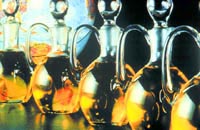What is a Fat?
Describing Fatty Acids
Fats in the Body
Fats in Food
Health Issues


What is a FatA fat, or Lipid - is made up of a molecule of glycerol in which one or more of its three original hydroxyl groups have been replaced by fatty acid chains. Approximately 95% of food lipids fall into a group called triglycerides (all three glycerol -OH groups are replaced). Other important lipids are phospholipids (e.g. emulsifying agents such as lecithin) and sterols (e.g cholesterol). Lipids can be liquid at room temperature, as in canola oil, or solid, as in margarine.
Describing Fatty AcidsFatty acids are described by the ratio of the number of carbon atoms in the chain to the number of double bonds and the position of the double bond is thought to have significance in health issues. Linoleic acid is 18:2 omega-6 fatty acid i.e it has an 18 carbon chain, two double bonds and the double bond lies between the sixth and seventh carbon atoms. Linolenic acid is 18:3 omega - 3 fatty acid.
Fats in the BodyIn our body, lipids or fats (fatty acids) have several essential and important functions. Fats
Small amounts of fat are essential for human nutrition. One essential fatty acid, linoleic acid, must be supplied in the diet, since the body cannot produce enough. Linolenic acid and arachidonic acid were once considered essential. However, we now know that the body can convert linoleic acid to arachidonic acid and linolenic acid can only partially replace linoleic acid. These fatty acids are necessary for the production of prostaglandins, thromboxanes and several other compounds. Prostaglandins and thromboxanes affect nearly every physiological system in the body.
Sources of Fatty Acids in FoodGood food sources of linoleic acid and somewhat lesser amount of linolenic acid, include seed oils from corn, cotton, soybean (50% linoleic acid) and peanuts (20-30% linoleic acid) as well as chicken fat. most other animal fats are low in this essential fatty acid. Linseed oil is an excellent source of linolenic acid.
Health IssuesDeficiency symptoms of essential fatty acids include decreased growth, dermatitis, fatty liver, impaired reproduction and impaired water balance. There is evidence omega-3 fatty acids (found in fish) are important in prevention of heart disease. There have been volumes written on the dangers of high cholesterol diets and their effects on coronary heart disease. To understand this problem we must recognise that cholesterol is essential to the normal functioning of our bodies and that there the two types of cholesterol:
| ||||||||||||||||||||||||||||||||||||||
